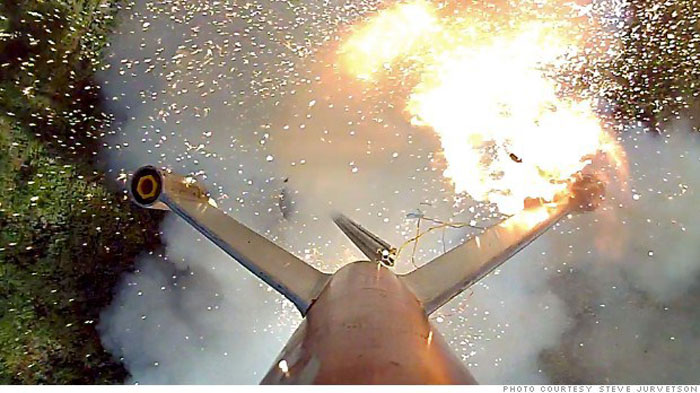.

The explosive first flight of one of Jurvetson's son's rockets in October 2013
.
FORTUNE -- Steve Jurvetson doesn't remember which came first, the hobby or the investment interest. But he does remember going out to Nevada's Black Rock Desert with his son for the first time in 2005 to witness a do-it-yourself rocketry event after he and his son began dabbling in model rockets.
"We saw these enormous rockets, and I remember thinking 'That's just crazy stuff, I would never do something like that, that's nuts." Jurvetson says. "Fast-forward to today, and we're doing exactly that kind of stuff."
As a partner at Silicon Valley venture capital fund Draper Fisher Jurvetson, Jurvetson spends his working hours thinking about how technologies upend markets and seeking out the most novel, potentially paradigm-shifting startup companies he can find. But it's no coincidence that he also sits on the board of both SpaceX and PlanetLabs, a maker of small, low-cost earth-imaging satellites. (DFJ is invested in both companies.)
Jurvetson has long cultivated an interest space and spaceflight, and his office at DFJ's Menlo Park, Calif. headquarters is littered with Apollo-era NASA artifacts he's collected over the years. For the last decade, he and his sons have acted on that fascination in California's Central Valley and the Black Rock Desert, building and launching ever larger and more sophisticated rockets at DIY events held every few months.
"The kids got bigger, the rockets got bigger," Jurvetson says. "And we've had a really fun time pushing the envelope with how big or how fast we can build a rocket."
It's a hobby that dovetails nicely both with Jurvetson's investment interests as well as the broader arc of technology -- especially space technology -- in the 21st century. Since he began designing and constructing his first rockets in the middle of the last decade, the tremendous leaps and bounds of mobile devices have rapidly (some would say brutally) driven down the prices of chips, sensors, and other electronics to the point that anyone can now make a rocket imbued with technologies that allow for precise measurements of speed, altitude, and orientation. Jurvetson and his sons can now run detailed software simulations on a rocket design before they build (and potentially wreck) it, something that was unthinkable for most DIY rocketeers even a few years ago.
These same technological forces, plus a change of heart for the federal government, are democratizing access to space through private space launch and satellite companies, Jurveston says. That ongoing shift is transforming not only the art of the possible but the art of the financially feasible. "There were not obvious venture opportunities in space for a long time," Jurvetson says. "From when I started in 1995 until 2005 or 2006, I didn't see anything that looked even worth a first meeting. Now it's very different -- there are a whole bunch of them."
Some of the people pursuing those opportunities are rocket hobbyists themselves -- though "amateur" might not be exactly the right term. Jurvetson first met the team of former NASA scientists that now run DFJ-backed PlanetLabs on the rocket range. For whatever reason, rocketry maintains a strong allure for other Silicon Valley technologist-types as well. Busy schedules and something of a barrier to entry keep some of his colleagues on the outside looking in, "but anytime I mention it to any tech entrepreneur, they say how much they want to get out there," Jurvetson says. Some of them do: Aside from his sons, the person with whom Jurvetson launches most often is Erik Charlton, vice president of business at Nest.
Ask him about his hobby and Jurvetson enthusiastically responds, careening between a discussion of the rockets he's built and a road map of the myriad opportunities emerging in orbit, where both the space launch and satellite industries are going through periods of rapid transformation. He uses layman's language sprinkled with the jargon of a rocket scientist, hinting at a deep technical understanding of how all this works -- and how it all will work someday in the not-too-distant future. Jurvetson tells a story about the time he and his son pushed a rocket to Mach 2.5 -- approximately 1,900 miles per hour -- before a fin separated and caused a critical failure. "It was an instant yard sale in the sky, the entire thing shredded back into the components it was made of," he says.
There remains big opportunity in the satellite layer -- for applications, software, services -- that only comes when the cost-per-pound of launch cargo decreases, he says.
"The analogy would be when fiber optic plants got more built up and made the Internet more feasible," Jurvetson says. "Similarly when SpaceX and others create cheaper access to space, you'll have more satellite innovation, maybe even broadband for the entire planet. And presumably big money would be made in the software and services layer."
Silicon Valley's embrace of failure carries over to the desert, where launch failures are not of startups or products but of rockets that he and others in the DIY rocketry community regularly destroy while reaching for faster fasts and higher highs. Jurvetson's rocketry hobby isn't so different than his day-to-day search for investment opportunities in the most unique and undiscovered places: Some rockets touch the sky, others explode on the launchpad. It's an easy metaphor, but there's a reason both endeavors are discussed in similar terms.
"These things take so much time and effort to build, it's kind of like NASCAR," he says of his rockets. "If it weren't for the potential for a wreck, it would be a bit less exciting."
Kind of like a promising technology startup.
Quelle: CNN
5627 Views
